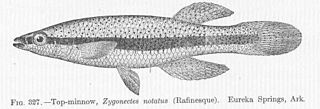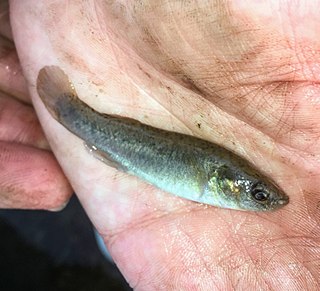
The Amblyopsidae are a fish family commonly referred to as cavefish, blindfish, or swampfish. They are small freshwater fish found in the dark environments of caves, springs and swamps in the eastern half of the United States. Like other troglobites, most amblyopsids exhibit adaptations to these dark environments, including the lack of functional eyes and the absence of pigmentation. More than 200 species of cavefishes are known, but only six of these are in the family Amblyopsidae. One of these, Forbesichthys agassizii, spends time both underground and aboveground. A seventh species in this family, Chologaster cornuta, is not a cave-dweller but lives in aboveground swamps.

The mummichog is a small killifish found along the Atlantic coast of the United States and Canada. Also known as Atlantic killifish, mummies, gudgeons, and mud minnows, these fish inhabit brackish and coastal waters including estuaries and salt marshes. The species is noted for its hardiness and ability to tolerate highly variable salinity, temperature fluctuations from 6 to 35 °C, very low oxygen levels, and heavily polluted ecosystems. As a result, the mummichog is a popular research subject in embryological, physiological, and toxicological studies. It is also the first fish ever sent to space, aboard Skylab in 1973.

The banded killifish is a North American species of temperate freshwater killifish belonging to the genus Fundulus of the family Fundulidae. Its natural geographic range extends from Newfoundland to South Carolina, and west to Minnesota, including the Great Lakes drainages. This species is the only freshwater killifish found in the northeastern United States. While it is primarily a freshwater species, it can occasionally be found in brackish water.

The blackstripe topminnow, Fundulus notatus, is a small freshwater fish in the family Fundulidae, found in central North America.

The trispot darter is a species of freshwater ray-finned fish, a darter from the subfamily Etheostomatinae, part of the family Percidae, which also contains the perches, ruffes and pikeperches. It is endemic to northern Georgia and southern Tennessee in the United States, where it occurs in the Conasauga River and its tributaries and historically in the Alabama River system. It requires two interconnecting habitats; outside the breeding season it occupies the peripheral zones of the main river, with slow-moving water and silt gravel substrates with vegetation cover; during the breeding season it moves to warmer water with a clay-bottomed substrate with much vegetation. The population of this fish is declining due to loss of suitable habitat because of stream impoundment and land development. The International Union for Conservation of Nature has assessed its conservation status as being "vulnerable".
The Barrens topminnow is a species of freshwater fish in the family Fundulidae, which is in need of management so that it may continue to and increasingly survive in the wild. There are many potential causes of decline of this species including the invasive western mosquitofish that will replace native species on a population level, wadding piscivorous birds preying on adults, and the overall restricted distribution of the species. Managing for this species is vital for its success, but to do so there must be an understanding of the species' characteristics. It is endemic to a small portion of Tennessee in the Elk River and the West Hickory creek of the Cumberland river drainage. living up to only 3 years the life span of F. julisia is very short. In many cases the majority of the population does not even reach that age. Most adult males are eaten by birds because of their bright coloration during breeding season. Current management plans are in place for the improvement of the species such as captive breeding and reintroduction, and also private management of streams and land. Yet, more can be done to aid them in their survival efforts. Buffer zones around streams can be created to promote the health of the stream and close observation of the introduced populations needs to be a priority. With only three small original populations left in the wild it is important that species survive in captivity, but more so in its natural environment.

The saltmarsh topminnow is a species of killifish for the family Fundulidae. It occurs in the costal wetlands of the Gulf of Mexico in the United States.
The Bermuda killifish is a small fish which is endemic to the islands of Bermuda in the western Atlantic Ocean. It belongs to the genus Fundulus in the killifish and topminnow family, Fundulidae.

The golden topminnow is a fish of the genus Fundulus and is a United States native fish mostly distributed throughout the southeast, ranging from Kentucky and Ohio south into Florida. Although it has such a wide distribution throughout the south, the habitats and micro-habitats that it occupies do not differ much from one area of distribution to others. The golden topminnow is a small surface feeding fish that tends to reproduce late in the spring season and on into the early parts of the summer, and although the fry reach maturity fairly quickly the longevity of the golden topminnow is quite short. Because the golden topminnow is lower in the trophic level and is a small fish, it primarily feeds on small and/or drifting organisms at, or near the surface of, vegetated areas. This particular topminnow is not currently listed as an endangered species, nor does it have any particular type of management plan.
The Stippled studfish is a small freshwater fish which is endemic to the Tallapoosa River system in Georgia and Alabama, USA; and Sofkahatchee Creek in Alabama. It belongs to the genus Fundulus in the killifish and topminnow family, Fundulidae.

The Starhead topminnow is a native United States species that ranges from the Ouachita River drainage in Louisiana, the Big Black river in Mississippi, and extends northward into the Mississippi River and Lake Michigan basins to the southern Michigan and southern Wisconsin areas. The Starhead topminnow is endangered due to the removal of aquatic vegetation and the continued development of land that infringes on its habitat.

The northern studfish is the largest of the killifish and is native to the southcentral United States.
The blackspotted topminnow, Fundulus olivaceus, is a species of fish in the family Fundulidae: the topminnows and North American killifishes. It is native to the south-central United States, where it is known from the drainages of the Mississippi River from Illinois to the Gulf of Mexico and as far west as Galveston Bay.
The southern studfish is a ray-finned fish of the family Fundulidae, the tooth carps, that is native to the southeastern United States.

The plains topminnow is a species of freshwater topminnow found in North America. The fish has a small range within the United States of America which consists of two major populations.

The bayou killifish or bayou topminnow is a topminnow-like fish that thrives primarily in the shallow waters off the shores of the Americas, as well as fresh and brackish waters. Feeding off of small vertebrates and invertebrates, this fish displays reproduction techniques unique to its species.

Fundulus nottii, the bayou topminnow or southern starhead topminnow, is a fish of the family Fundulidae [1] found in the southeastern United States.

The spotfin killifish is a member of the genus Fundulus. This hardy fish is notable for spending its entire life in sporadically flooded salt marsh habitat, sheltering in shallow pools, puddles, and small tidal rivulets. It closely resembles the mummichog in shape and coloration, but the two species can be distinguished by dorsal fin ray count: 8–9 in the spotfin versus 11–12 in the mummichog. Additionally, the dorsal fin of F. luciae originates farther back, and slightly behind the anal fin origin; in the mummichog, the dorsal fin begins anteriorly to the anal fin origin. The spotfin killifish is named for the pronounced ocellus found on the posterior dorsal fin of adult males. It is a small fish, seldom attaining 50 mm in total length. Its distribution extends along the U.S. east coast from Massachusetts to Georgia.

Elassoma evergladei, or the Everglades pygmy sunfish, is a species of fish from the genus Elassoma that is endemic to North America.

The banded topminnow is a North American species of temperate freshwater killifish belonging to the genus Fundulus of the family Fundulidae.
















